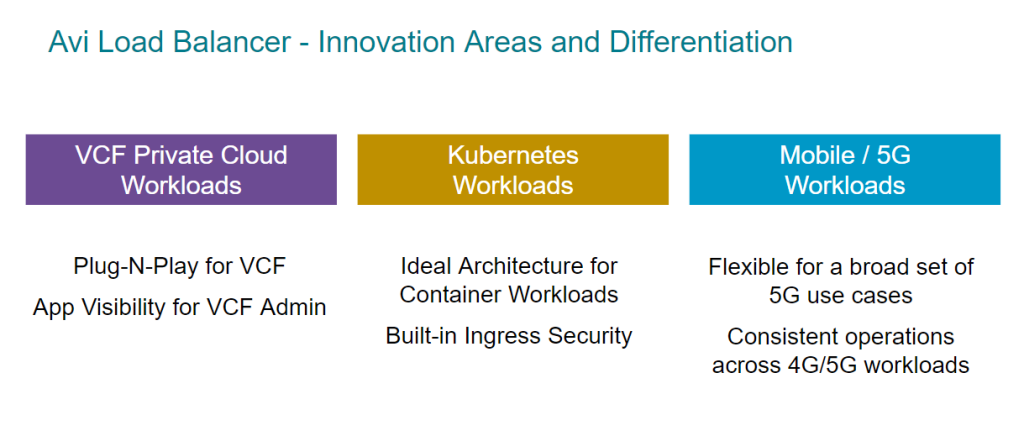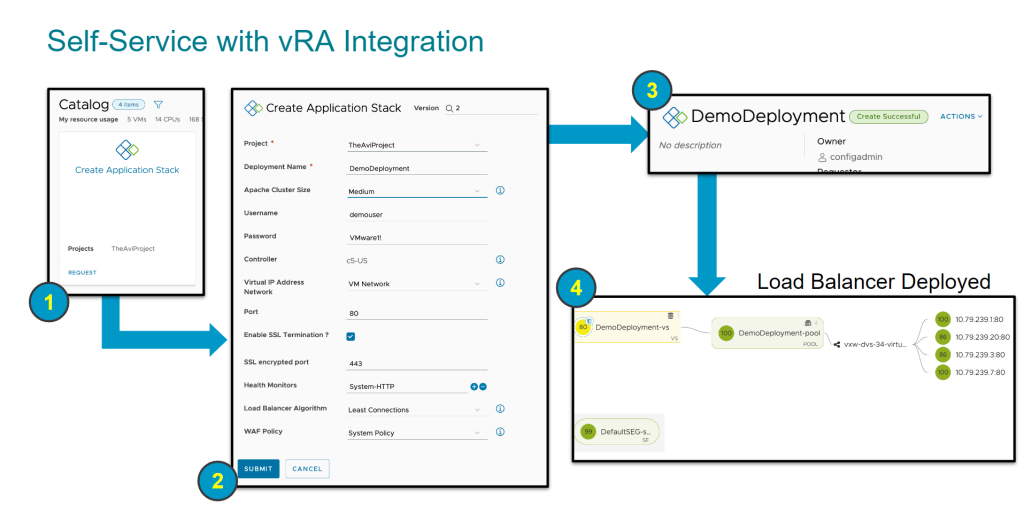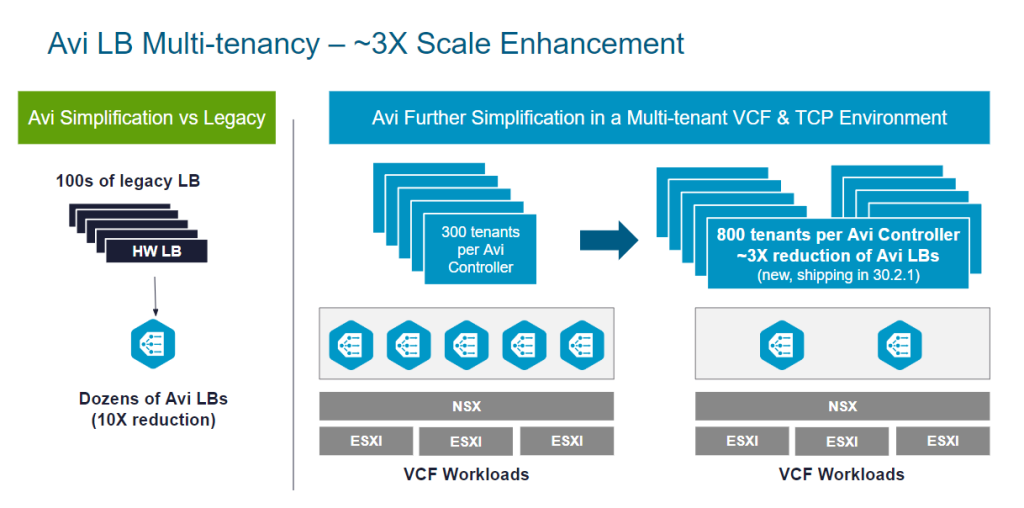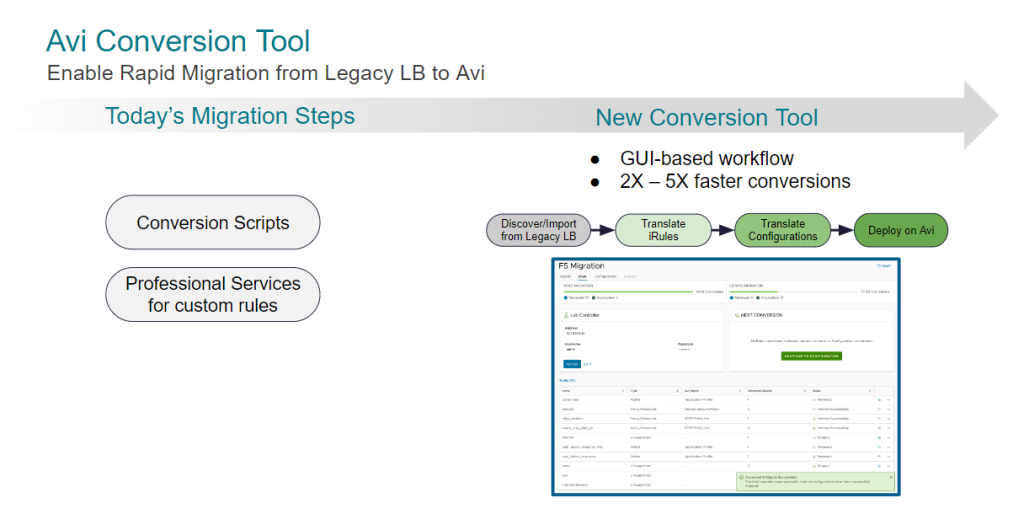New Capabilities Enable Self-Service Load Balancing, Expand Container Ingress Use Cases, Enhance Mobile/5G Support, and Automate Conversion from Legacy Load Balancers to Avi
Avi Load Balancer is the industry’s first software-defined load balancer (LB) for hybrid clouds that delivers a distributed architecture with built-in automation and deep application visibility. Avi’s pioneering innovations have enabled IT teams to deliver load balancing at the speed of applications while ensuring elasticity (scale-out and scale-up) and a consistent operating model across hybrid multi-cloud environments, including VMware Cloud Foundation (VCF), traditional data centers as well as native public clouds for virtualized, Kubernetes and bare metal workloads. Our recent vision blog also highlights this unified load balancing approach with a “single SKU” Avi offering for all features and capabilities.

Avi Load Balancer is redefining the innovations bar across the following dimensions:
- VCF Private Cloud Applications: Avi is the load balancer of choice due to its plug-and-play operating model for VCF, delivering the following unique advantages.
- Rapid LB deployment due to built-in integrations with vSphere and NSX
- Automated LB workflow with Aria Operations, formerly vRealize Operations (vROPs)
- LB self-service through integration with Aria Automation, formerly vRealize Automation (vRA) – new
- Application visibility extended to VCF admins to rapidly troubleshoot application related issues before involving the load balancing team
- Kubernetes Applications: As an ingress LB, Avi’s software defined and elastic architecture is ideally suited for the distributed and dynamic nature of container workloads. Avi’s advantages include
- Built-in automation with Avi Kubernetes Operator (AKO)
- Gateway API is a next gen Kubernetes ingress, significantly reducing the need for customizations via annotations and custom resource definitions (CRDs), and also future proofs customers for Kubernetes and serverless workloads – new
- Built-in ingress security – including Web Application Firewall (WAF) – to protect container workloads. No additional feature license required.
- Mobile and 5G Applications: Avi delivers a flexible and consistent load balancing solution for a broad set of telecom and mobile use cases.
- Natively multi-tenant, now delivering ~3X higher multi-tenancy with VCF and Telco Cloud Platforms (TCP) – new
- Full support for recently shipping TCP 4.0 – new
- Further enhancements to industry’s first software-defined IPv6 load balancer (with decoupled IPv6 control and distributed data planes) for on-prem and cloud – new
- Legacy LB to Avi Conversion Tool – new: To simplify and speed-up Avi deployments in brownfield environments, we are announcing the Avi Conversion Tool. The tool:
- discovers legacy LBs
- extract configurations
- converts legacy LB configurations and custom rules (e.g. iRules) to Avi
- deploys configurations on Avi
This tool will accelerate legacy-to-Avi migrations delivered by our professional services team.
Self-Service Load Balancing for VCF Private Cloud
Avi Load Balancer is the load balancer of choice for VCF, fully integrated and supported with plug-and-play ease of use. Avi provides unprecedented application visibility to help a VCF admin rapidly troubleshoot and root cause application performance issues within minutes. Customers who want to enable self-service capabilities to DevOps teams find legacy load balancers unbearable as it takes weeks to provision, requiring many manual steps and multiple tickets. Avi’s integration with Aria Automation offers application teams self-service access to L4-L7 load balancing services (see blog: Enabling Load Balancing as a Service for VCF-based Private Cloud). This enables application and infrastructure teams to immediately deploy load balancing at the time of application provisioning, with minimal know-how of load balancing technology or the need to create manual tickets. The integration helps customers lower operational cost, simplify and automate the provisioning and capacity management of load balancing. Watch this short demo video to see how easy it is to enable load balancing as a service using Aria Automation.

Boost Avi Load Balancer Multi-tenancy by ~3X
Enterprises are deploying large-scale applications that require elastic and resilient load balancing. Multiple teams and tenants need to have access to the private cloud infrastructure. Avi Load Balancer has made significant improvements on performance and scale, boosting multi-tenancy support by nearly 3X. Customers can now manage more Avi Service Engines (load balancers) for every Avi Controller deployed. Each controller can support up to 800 Tier-1 routers for VMware NSX-T Cloud. Customers not only have fewer controllers to manage, but save significant operational costs compared to legacy load balancers. As a result, the same team can manage more tenants, so productivity is enhanced. VMware Cloud Service Providers, formerly VMware Cloud Provider Program (VCPP), leverage Avi Load Balancer to streamline cloud operations and elevate service offerings. See details in this Feature Friday YouTube webinar.

Avi for Ingress Load Balancing of Kubernetes and Serverless Workloads
Containers are ephemeral and elastic in nature, spinning up and down all the time, outdating hardware load balancers with legacy architectures designed before cloud and containers. Increasingly, production workloads are deployed on Kubernetes platforms, making open-source options not viable for enterprise requirements. To keep pace with the speed of application deployment and deliver enterprise-grade load balancing and ingress solutions, Avi Load Balancer offers the ideal architecture for container workloads with built-in ingress security.
Avi offers integrated ingress services which include ingress controller, load balancing, multi-cluster global server load balancing (GSLB), WAF, application analytics in a single platform. For customers who have deployed Avi for their virtualized workloads, it’s an easy extension onto the Kubernetes workloads with the same user interface, consistent workflows and policies. Avi is agnostic to container platforms and supports VMware Tanzu, RedHat OpenShift, Tanzu Application Service (TAS, previously Pivotal Cloud Foundry) and more.
Avi Load Balancer is introducing general availability (GA) support for Gateway API in the AKO 1.12.1 release. Avi adds advanced L7 routing functionalities including serverless Kubernetes support, header modification, cookie insertion, and a key set of HTTProute functionalities. Avi offers advanced traffic routing, better scale and observability on a per route basis, without the need for CustomResourceDefinition (CRDs) or annotations.
Extending Software-Defined Approach to Mobile and 5G Applications
With the distributed IPv6 support enabled by Avi’s unique software-defined architecture and Telco Cloud Platform 4.0 support, VMware Avi Load Balancer continues to offer a broad set of use cases from 4G VM workloads and Virtual Network Functions (VNFs) to 5G container workloads and container network functions (CNFs). A large telco customer first deployed Avi in their corporate IT network for its cloud-like experience. Impressed by its ease of use and application analytics, the network team introduced Avi to its core telco team, who decided to extend Avi into the Telco Cloud Platform that enables 5G network for Kubernetes workloads. From an operations perspective, it’s exactly the same platform for both environments, making it extremely easy to train staff and collaborate on resolving application issues that can involve multiple teams. Multi-tenancy has been a key requirement for telco use cases and the scale has been greatly enhanced with the release. Avi provides granular rule-based access control (RBAC) to different tenants and teams.
Legacy Load Balancer to Avi Conversion Tool
To further make it easier to migrate off legacy load balancer hardware appliances and accelerate the journey onto VCF private cloud, Avi Load Balancer is announcing the initial availability (IA) of an UI-based conversion tool that takes legacy policy rules, converts configurations into built-in Avi features as well as into Avi DataScript (a Lua-based scripting language). Customers break the chain off legacy load balancers, from convoluted box-by-box configurations to simple policy management from a centralized dashboard.

Learn More
- VMware Avi Load Balancer 30.2.1 Release Note
- Avi Kubernetes Operator (AKO) 1.12.1 Release Note
- Enabling Load Balancing as a Service for VCF-based Private Cloud
- Come and talk to Avi experts at VMware Explore Las Vegas (Aug 26-29, 2024) and VMware Explore Barcelona (Nov 4-7, 2024)








